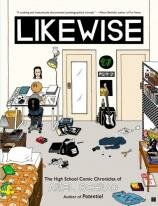School Days: Ariel Schrag Discusses Likewise
Ariel Schrag began her memoirs of her high-school years while still in high school. Every summer after a school year ended, she’d write up her experiences in graphic memoir form, much to the joy and chagrin of those she knew and loved. Some friends and family members balked at being depicted, while others found the experience wonderful.
Beginning with Awkward (freshman year), and continuing on through Definition (sophomore), Potential (junior), and the just-released Likewise (senior). Along the way, Schrag realized her sexual orientation (first thinking she was bisexual, then understanding her lesbianism), made friends, had typical and not-so-typical teenage experiences, and much more. Now, with the final volume of her critically acclaimed high-school series just published, she reflects on the books and talks about what’s next.
Your final memoir of your high-school years, Likewise, has just been published. What will readers learn about you and your life in this book?
That I’m crazy? Hopefully not just that. That the comic overtook my life in the way that I think any obsession can overtake anyone’s life. One thing becomes the reference point for everything. I wanted to see if I could fit everything I thought about life at age 18 into one perfectly organized, hopefully beautiful book. The idea was to put my entire self on paper. To turn all these experiences and thoughts and emotions into something that made sense.
Your style seems to have changed dramatically between Awkward and Likewise. What do you see as the major growth in your work between when you started and now?
It was really just the same as growing up. Each book goes deeper into the character, so in Awkward, it’s mainly superficial things like, “And then we went to the Nine Inch Nails concert and then we smoked a bidi,” and in Likewise, it’s 30 pages of an internal stream-of-consciousness monologue on a silent bus trip. With each book, I was trying to get closer and closer to the idea of “truth.”
How do you feel about your teen years now, looking back over them and reliving them in print this way?
My memories of my teen years are definitely all intermingled with images from the comic. So in a way, while my goal was to get closer to this idea of truth, I’ve ended up with a very warped, fictionalized version of my life. The way I made sense of things back then isn’t necessarily the way I would make sense of them now, but the comic becomes the written, permanent record, and my brain is just a mishmash of fluctuating memories and ideas. I’ve discovered old letters that I wrote to people during my teen years that represent a completely different reality of what was going on and how I felt about it all. It’s shocking how many different “truths” can exist simultaneously.
Do you feel a connection to the person you were back then? Are you surprised at how you’ve changed?
It would be really disturbing if I hadn’t changed. Everyone changes drastically from the way they were in high school. But at the same time, I do still feel like the same person. It’s mainly just weird that there’s this document of these particular four years of my life, so those years end up seeming more significant than anything else, when really who I was when I was seven and who I was when I was 22 have just as much to do with who I am now. I do often feel a certain pressure when I get to know new people to remove myself from the comic character. I don’t want it to loom as the “real” me.
Has there been negative reaction to your work and its honesty?
It did get difficult between me and some of the people in the book whose lives I really exposed. When I was a teen, I just had this obsessive drive to do the comic as truthfully and honestly as I could, and that meant exposing other people as well. I wasn’t completely f---ed up about it—I wouldn’t write specific things that people asked me not to, and with Likewise I showed an early version of the book to all the major characters and made changes based on anything they didn’t want included. But still, I definitely had a “f--- everyone, the only thing that matters is art” attitude. I want to continue writing autobiography, and that means writing about other people, but I would go about it different now, with more of a general sense of adult responsibility.
Was it difficult to be so honest about your life? Did you ever feel as if you were sharing too much?
I didn’t think about it in those terms. I basically just had an idea I wanted to get across, and would do whatever I needed to do to express that. The comic was about making sense of intimate emotions and experiences, so that meant detailing those experiences. It had always bothered me how in books and movies the plot would fade out as soon as people got into bed—that was the part I was most curious about, the part I wanted to try to understand.
What can you tell us about the movie version of Potential in the works? When do you expect it to come out, and how far along is it?
We are currently casting. We’ll see!
What drew you to comics in the first place as a format to use to best express your story?
I think comics are just the way my brain works. When my sister and I were young, we would spend the majority of our time drawing together in the kitchen. We’d each be doing our separate drawings and telling the story out loud to each other as we drew. So my sister would be going, “This family is the richest family in the entire world, Susanna can have anything she wants” and at the same time I’d be like, “Tommy’s just arrived at the orphanage, no one wants to be his friend.” Eventually I started writing down the story at the tops of the paper and in speech balloons.
How did you get started with comics?
The first long comic book I drew was in third grade and it was called “Life with Lucy Hound.” It was about a nine-year-old girl who wants nothing more in this world than to have a dog. At the beginning, she’s very poor and has perpetual dark circles under her eyes, but then one day her dad invents something and they become unbelievably rich and move to Montclair and she gets a dog. She also struggles with whether or not she should try to act “cool” or not.
Another comics project I did was in eighth grade, which was a series of newspaper-style strips called “Live It Like Me.” It starred a girl in eighth grade named Alexis who each strip has to put up with her embarrassing nerd parents and her annoying tagalong little sister. I also gave her a boyfriend, but she was bored by him.
Who were some of your earliest influences in the field?
My earliest, biggest influence was Disney. There was something about the exaggerated emotion and movement of the characters in the early Disney films that perfectly captured how I felt. Like seeing your emotions dancing in front of you. The early films are gorgeous too, with their painted backgrounds. I loved the idea of this alternate, perfect universe.
Another huge influence was the comic strip For Better or for Worse. I loved the real-time aspect, that as I grew up, the Patterson kids grew up too, and we could go through the ups and downs of elementary school and then middle school and then high school together. Johnston is an amazing cartoonist; her characters’ expressions and body language, the elaborate storylines that would stretch for weeks. She was a huge inspiration. I’ve reread her comics dozens of times.
Are you surprised by the reaction to your work and the influence that it’s had on other comics memoirists?
One thing that’s really important to me is how the comics have helped GLBT teenagers. I’ve had people come up to me and tell me how they used the comic to talk to their parents, and how much it helped them understand what they were going through. I didn’t set out to write the comics with any sort of didactic goal, but it means so much to think that they actually help people.
In terms of other cartoonists, I’ve gotten a lot of letters from people who have said that the comic inspired them to open up more and write about what they’ve really experienced or are thinking. I love reading autobiographical comics, so the idea that I’m inspiring more people to make them is great.
Tell us about the Graphic Novel Workshop you teach at the New School. What does it entail? What’s been involved in teaching it?
The Graphic Novel Workshop is basically a way for me to talk about everything I love about comics. It’s been really fun to pour over all my favorite comics and figure out what exactly it is about them that works, and how each aspect fits into the different methods of craft and expression. It’s great to see people draw comics for the first time, too. There’s always going to be that fresh originality that comes with doing something you’ve never done before.
Do you think comics have a valuable place in the classroom—or more specifically, do you think they should have a more valuable place in the classroom, and do you see this changing now?
Comics are getting more mainstream and literary/artistic attention, so yes, they are and will become more present in the classroom. Which is great. People that used to say comics weren’t real literature 10 years ago are already feeling pretty stupid.
Do you plan to continue your autobiographical series after your high-school years?
I want to write more autobiographical comics, but definitely nothing that would be seen as an extension of the high school project. The high school comics are very much a contained series. They’re confessional and exhibitionist in a way that is uniquely teenage, and I just don’t have the need to tell that particular kind of story anymore. The high-school comics were also very much about recording experiences in a journalistic real-time way. My autobiographical comics in the future will be more about looking at a cohesive specific story or event, rather than the unraveling of time. I’m excited to start and see how different they’ll be.
-- John Hogan








